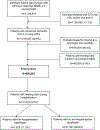Pre-hospitalization dysphagia and feeding tube placement in nursing home residents with advanced dementia
- PMID: 38156795
- PMCID: PMC12172853
- DOI: 10.1111/jgs.18729
Pre-hospitalization dysphagia and feeding tube placement in nursing home residents with advanced dementia
Abstract
Background: Despite research demonstrating the risks of using feeding tubes in persons with advanced dementia, they continue to be placed. The natural history of dysphagia among patients with advanced dementia has not been examined. We conducted a secondary analysis of a national cohort of persons with advanced dementia staying at a nursing home stay before hospitalization to examine (1) pre-hospitalization dysphagia prevalence and (2) risk of feeding tube placement during hospitalization based on preexisting dysphagia.
Methods: A retrospective cohort study consisting of all nursing home (NH) residents (≥66 years) with advanced dementia (Cognitive Function Scale score ≥2), a hospitalization between 2013-2017, and a Minimum Data Set (MDS) 3.0 assessment within 120 days before hospitalization. Pre-hospitalization dysphagia status and surgically placed feeding tube insertion during hospitalization were determined by MDS 3.0 swallowing items and ICD-9 codes, respectively. A multivariate logistic model clustering on hospital was used to examine the association of dysphagia with percutaneous endoscopic gastrostomy (PEG) feeding tube placement after adjustment for confounders.
Results: Between 2013 and 2017, 889,983 persons with NH stay with advanced dementia (mean age: 84.5, SD: 7.5, and 63.5% female) were hospitalized. Pre-hospitalization dysphagia was documented in 5.4% (n = 47,574) and characterized by oral dysphagia (n = 21,438, 2.4%), pharyngeal dysphagia (n = 24,257, 2.7%), and general swallowing complaints/pain (n = 14,928, 1.7%). Overall, PEG feeding tubes were placed in 3529 patients (11.2%) with pre-hospitalization dysphagia, whereas 27,893 (88.8%) did not have pre-hospitalization dysphagia according to MDS 3.0 items. Feeding tube placement risk increased with the number of dysphagia items noted on the pre-hospitalization MDS (6 vs. 0 dysphagia variables: OR = 5.43, 95% CI: 3.19-9.27).
Conclusions: Based on MDS 3.0 assessment, only 11% of PEG feeding tubes were inserted in persons with prior dysphagia. Future research is needed on whether this represents inadequate assessment or the impact of potentially reversible intercurrent illness resulting in feeding tube placement.
Keywords: Alzheimer's disease; dysphagia; enteral nutrition; swallowing.
© 2023 The Authors. Journal of the American Geriatrics Society published by Wiley Periodicals LLC on behalf of The American Geriatrics Society.
Conflict of interest statement
Figures
Similar articles
-
Feeding tubes and the prevention or healing of pressure ulcers.Arch Intern Med. 2012 May 14;172(9):697-701. doi: 10.1001/archinternmed.2012.1200. Arch Intern Med. 2012. PMID: 22782196 Free PMC article.
-
Feeding tubes and health costs postinsertion in nursing home residents with advanced dementia.J Pain Symptom Manage. 2014 Jun;47(6):1116-20. doi: 10.1016/j.jpainsymman.2013.08.007. Epub 2013 Oct 7. J Pain Symptom Manage. 2014. PMID: 24112820 Free PMC article.
-
Oropharyngeal dysphagia impact of pneumonia risk in neurological patients receiving enteral tube feeding: Insights from a gastroenterologist.Neurogastroenterol Motil. 2025 Jan;37(1):e14946. doi: 10.1111/nmo.14946. Epub 2024 Oct 16. Neurogastroenterol Motil. 2025. PMID: 39415547
-
[Management of dysphagia in the institutionalized elderly patient: current situation].Nutr Hosp. 2002 May-Jun;17(3):168-74. Nutr Hosp. 2002. PMID: 12149817 Review. Spanish.
-
Enteral tube feeding for dysphagic stroke patients.Br J Nurs. 2015 Feb 12-25;24(3):138, 140, 142-5. doi: 10.12968/bjon.2015.24.3.138. Br J Nurs. 2015. PMID: 25679242 Review.
Cited by
-
Can invasive interventions be avoided with a holistic swallowing therapy program in older patients in intensive care units: percutaneous endoscopic gastrostomy tubes or oral intake?Front Neurol. 2025 Jan 22;16:1484493. doi: 10.3389/fneur.2025.1484493. eCollection 2025. Front Neurol. 2025. PMID: 39911454 Free PMC article.
-
Artificial Nutrition Preferences Among California Nursing Home Residents.J Am Geriatr Soc. 2025 May 19:10.1111/jgs.19536. doi: 10.1111/jgs.19536. Online ahead of print. J Am Geriatr Soc. 2025. PMID: 40384589
-
Use of Feeding Tubes Among Hospitalized Older Adults With Dementia.JAMA Netw Open. 2025 Feb 3;8(2):e2460780. doi: 10.1001/jamanetworkopen.2024.60780. JAMA Netw Open. 2025. PMID: 39976967 Free PMC article.
References
Publication types
MeSH terms
Grants and funding
LinkOut - more resources
Full Text Sources
Medical
Research Materials
Miscellaneous


